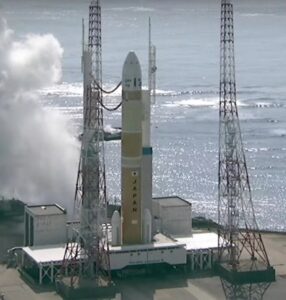With mere seconds left before its planned lift-off from the Tanegashima launch site, Japan aborted the maiden flight of its new expendable H3 rocket.
The H3 flight, which used the H3-22S variant, was scheduled to launch at 0137:55 GMT on 17 February. The main stage’s liquid oxygen (LOX)/liquid hydrogen-fed LE-9 engines had been ignited but were immediately switched off after computer systems detected an anomaly. It was later reported that an electrical lead supplying power to the first stage engine(s) had a fault. The H3 is the launch vehicle Japan hopes will compete with the SpaceX Falcon 9 and with Europe’s Ariane 6, which is yet to fly. The abort sequence was able to take place because the rocket’s solid SRB-A3 rocket boosters, which are impossible to turn off, had not yet been ignited.
The H3-22S variant uses two LE-9 engines that operate a highly efficient expander-bleed cycle, in which liquid hydrogen is used to cool the engine before it undergoes a thermal induced change of phase into gas. It then drives the turbopump before it is injected back into the nozzle extension. Such an expander cycle is unusual on a large engine. It is more commonly used on smaller upper-stage engines such as the H3’s own upper-stage engine, the LE-5B-3.
The satellite onboard H3 was JAXA’s ALOS-3 Earth observation satellite which has a 0.8 m ground resolution. The plan was to launch the satellite into a near polar Sun-synchronous low Earth orbit. A new launch attempt was expected within weeks.
H3 F1 failed to take off. Luckily it didn't end up exploding at the pad.
Wishing JAXA figure out the issue soon and looking forward to seeing the next attempt https://t.co/lw4LgnpYjd pic.twitter.com/SQiaDZCqnF— China 'N Asia Spaceflight









